
Ask Mick McGinnis what sports he likes to play, and you’ll get a spirited answer. “The 100 meters and 200 meters in track,” begins 16-year-old Mick, who holds a black belt in taekwondo. “I won a gold medal at the Special Olympics Ohio State Summer Games! In swimming, my favorite is the 50-meter front stroke and the relay. I play golf with my dad.”
Mick, who was born with Down syndrome, also loves to ride his bicycle and play basketball, prompting him to serve as the team manager for the 7th grade boys’ basketball team at Brunswick Middle School during the 2021-22 season. Mick’s mom Michele explains, “Mick has always had an amazing, positive attitude. He’s a very active kid and always has been.”
It was surprising when Mick complained of leg pain before Christmas in 2021, something Michele and her husband, Mike, attributed to growing pains in their teenager. But less than a month later, when the school nurse called Michele to say Mick had come to her three times saying his knees and feet ached, Michele scheduled an appointment with his pediatrician.
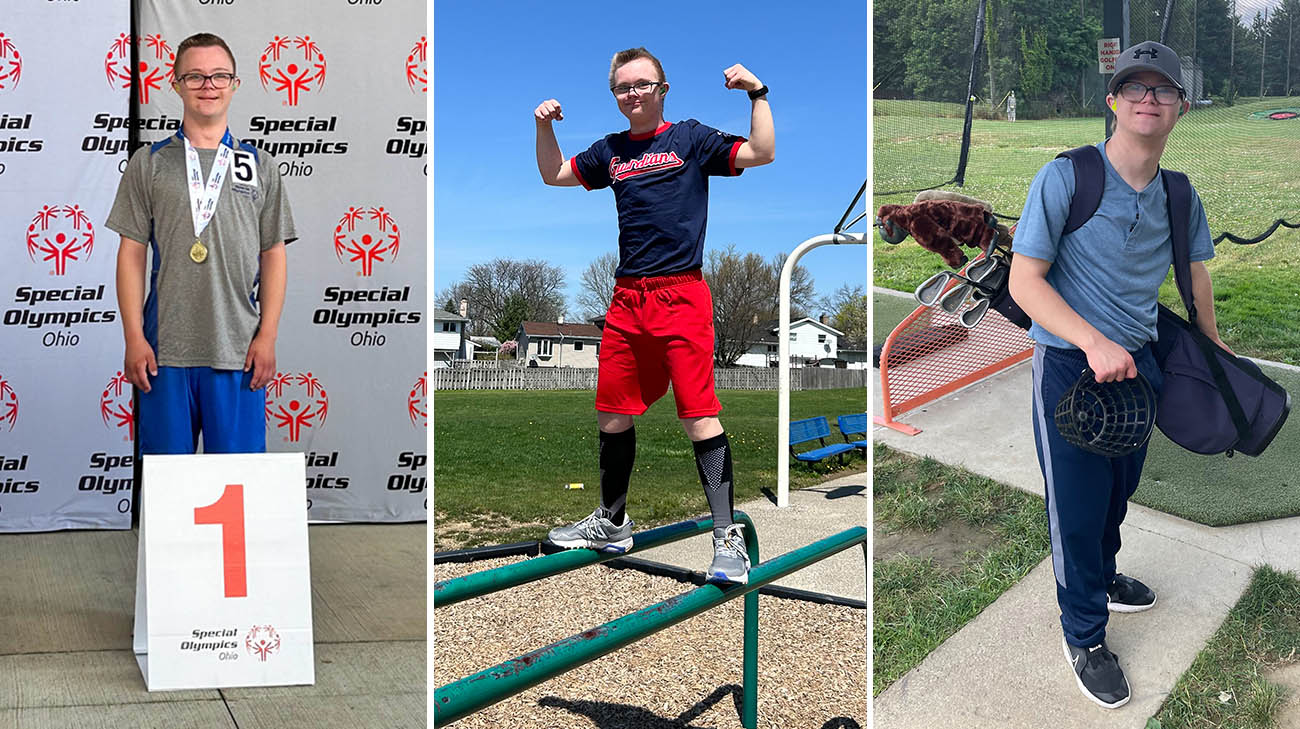
Mick has always been an active kid. He loves playing sports and even won a gold medal at the Special Olympics Ohio State Summer Games. (Courtesy: Michele McGinnis)
That began a whirlwind of activity, first at Cleveland Clinic Fairview Hospital and then at Cleveland Clinic Children’s, which culminated into a series of tests revealing Mick had a form of blood cancer called acute lymphoblastic leukemia (ALL). According to the National Cancer Institute, children and adolescents with Down syndrome are 10 to 20 times more likely to develop leukemia than children without the condition.
Michele recalls, “I was terrified. It’s such a scary thing to hear. When the doctors laid out the treatment plan, it was quite daunting to see how long a process fighting leukemia is, especially when you add in the extra potential complications because of Down syndrome.” Additionally, one hour after his diagnosis, another test result revealed Mick had contracted COVID-19.

Mick is grateful for support from his community and family, including his mom, dad and three sisters. (Courtesy: Michele McGinnis)
For most of the next six weeks, Mick was an inpatient at the hospital, enabling his medical team to closely monitor his condition as he began chemotherapy. During this period, Mick received multiple rounds of infusions, often passing the time by repeatedly tossing a small foam basketball towards a net his parents hung from the wall.
According to pediatric hematologist and oncologist Stefanie Thomas, MD, who has treated Mick since his diagnosis, “We usually have kids with underlying Down syndrome stay in the hospital for a month because they are at higher risks of infections and complications. Mick did really well initially.”
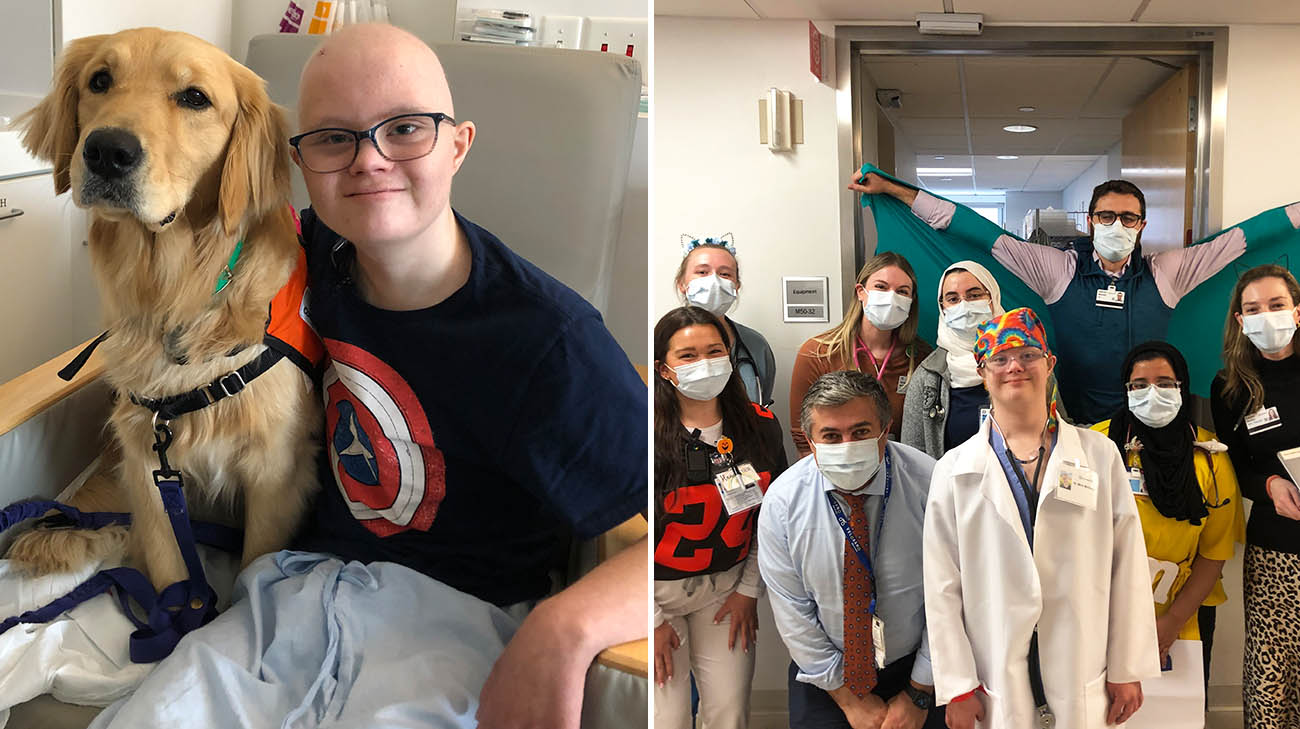
Mick has developed a close bond with all his Cleveland Clinic Children's caregivers, including one of the hospital's facility dogs, Trotter. (Courtesy: Michele McGinnis)
That suddenly changed in March 2022, two days after Mick was discharged from the hospital, when his eyes rolled, and he was unable to stand. Mick was slouching to one side and unable to respond to the frantic pleas from his mom.
He was having a life-threatening ischemic stroke, which occurs when a blood clot forms in the brain. It’s an extremely rare side effect from a chemotherapy medication Mick had been taking. Because of poor weather, which prevented a helicopter from transporting Mick back to Cleveland Clinic Children’s on main campus, he was rushed by Cleveland Clinic's Mobile Stroke Treatment Unit (MSTU), a unit where patients experiencing a stroke can be diagnosed and treated before arriving at the hospital.
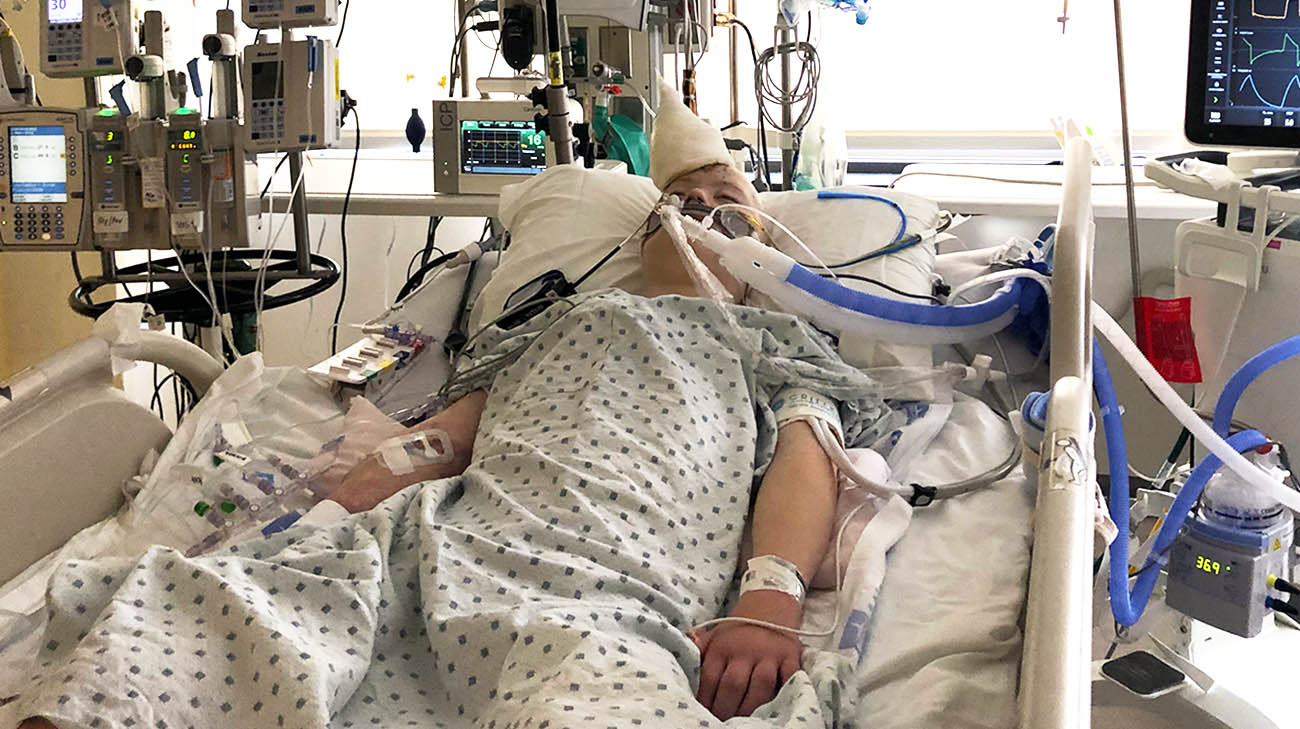
Mick at Cleveland Clinic, after experiencing a stroke. (Courtesy: Michele McGinnis)
Amid the chaos in the early hours after the stroke, Michele marveled at the calm and confident approach taken by a team of Cleveland Clinic specialists who assembled to save Mick’s life and mitigate the stroke’s damage. As she recalls, “One of the doctors said to me, ‘For most patients, we follow the book for treating leukemia. And then there’s Mick.’ They had to throw out the book and create a new treatment plan that works for him.”
While anticoagulant medications and multiple thrombectomy surgical interventions eliminated the blood clots, the damage was significant. To give his brain time to recover from the trauma, Mick – who was placed on a ventilator immediately after the stroke – was put in a medically induced coma. Lights in his room in the pediatric intensive care unit (PICU) were kept dim, and his parents and three older sisters couldn’t hold his hand or hug him. His brain needed as little stimulation as possible.
Finally, eight days later when Mick was brought out of the coma, the extent of the stroke’s damage was painfully evident. Mick couldn’t walk, talk, sit, move his fingers or swallow. “He had to relearn everything,” says Dr. Thomas, who adds Mick’s modified chemotherapy regiment resumed later that fall.
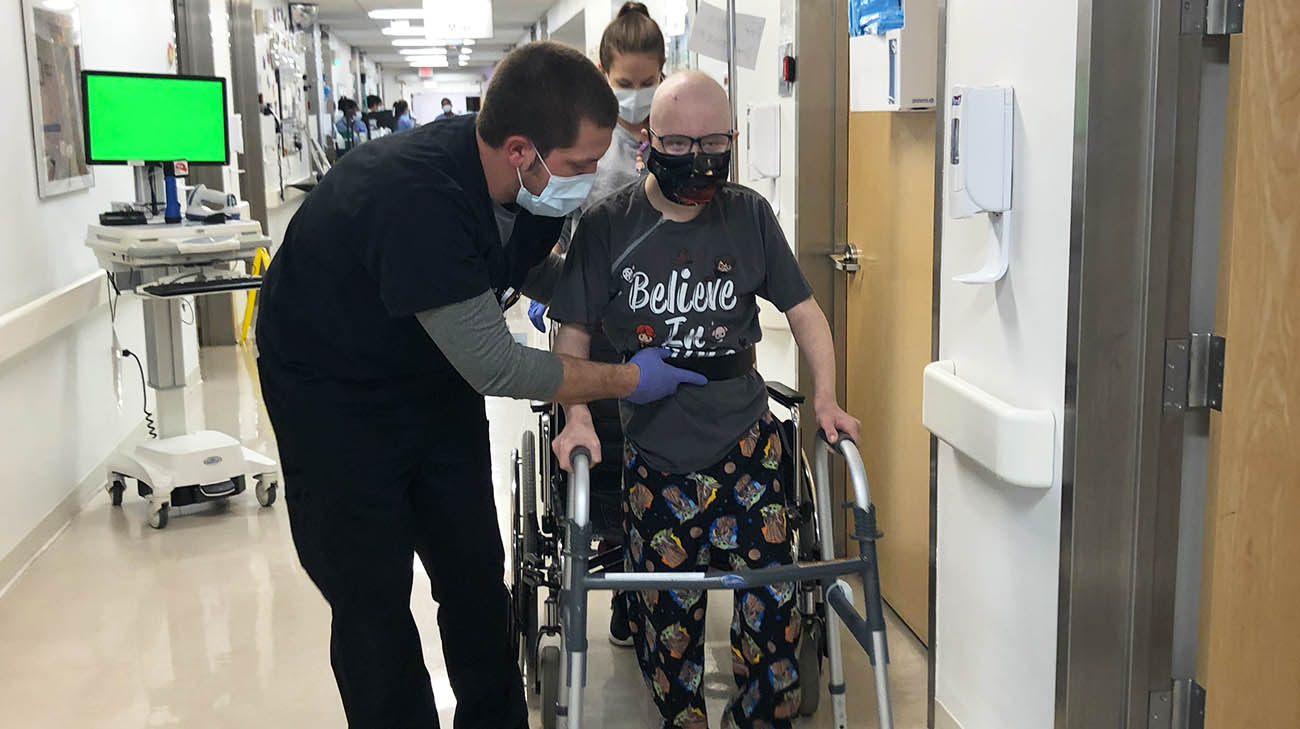
After his stroke, Mick had to relearn how to walk, talk and perform daily tasks. (Courtesy: Michele McGinnis)
For months, first as an inpatient and later through outpatient visits, Mick underwent daily sessions of physical and occupational therapy at the Cleveland Clinic Children's Hospital for Rehabilitation. Mick eagerly participated, showing the grit, determination and tenacity his mom says he has always displayed.
“Mick enjoys being an active kid. He was so driven to succeed because he wanted things to go back to how they were,” says Michele, who notes the day Mick was able to play with his foam basketball in his room again was a recovery highlight. “As a family, we have always focused on what is positive and possible for Mick. Even when it seems improbable.”
It was during his time in rehab that Michele and Mike learned about VeloSano, Cleveland Clinic’s cancer research fundraising initiative. Each year, riders and supporters participate in the VeloSano Bike to Cure event.
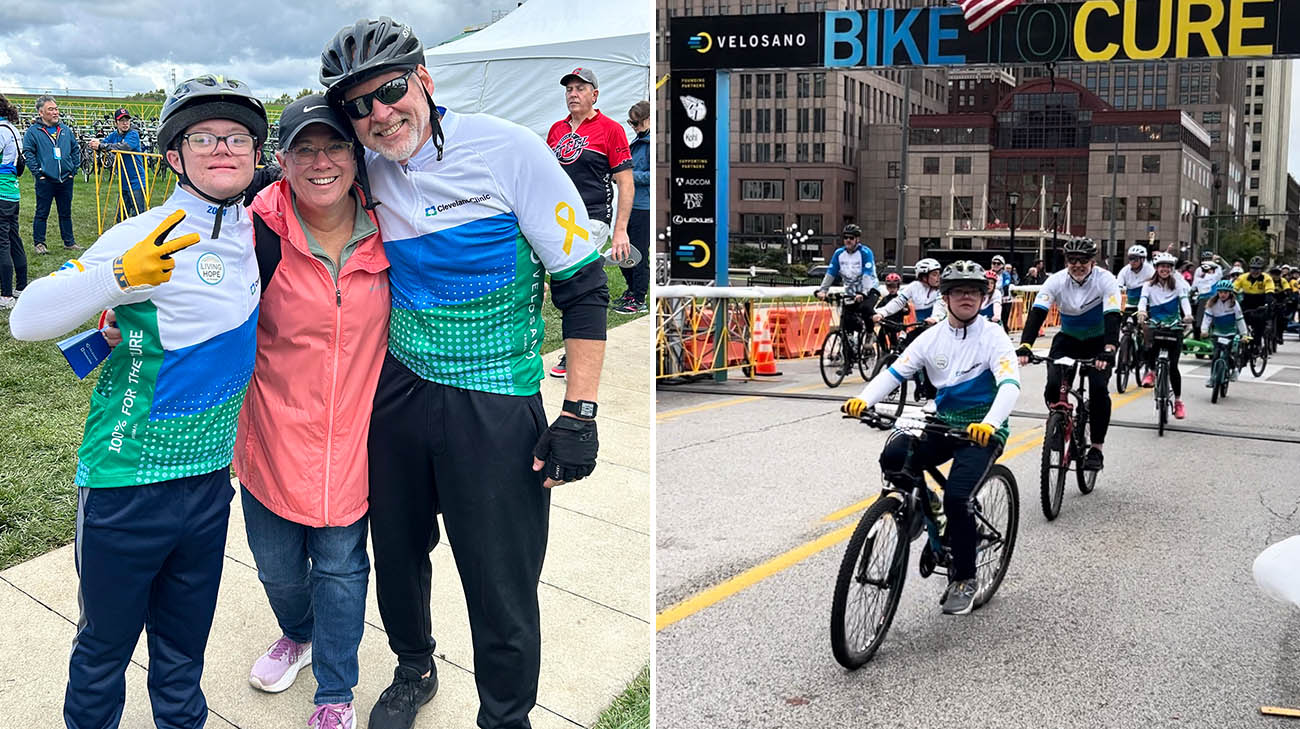
Mick, Michele, and Mike at VeloSano. (Courtesy: Michele McGinnis)
“My husband and I, watching him relearn how to walk, thought it would be amazing if he could ride his bike again. And an even loftier thing to dream about was if he could ride in VeloSano someday.”
In early September 2024, that’s exactly what happened. Not long after Mick “rang the bell” signifying the end of his chemotherapy treatment, he and his dad rode the 6-mile city loop in VeloSano Bike to Cure. Mick is now a high school sophomore and says choir and gym are his two favorite classes. He continues staying active and can be heard cheering on his favorite sports teams, the Cleveland Cavaliers and Cleveland Guardians.
As Dr. Thomas notes, “The biggest lesson I learned when taking care of Mick is that by focus, willpower, and leaning on the support from his family and community, Mick has been able to overcome anything that comes his way. He’s really a special kid.”
Related Institutes: Cleveland Clinic Children'sPatient Stories
Perseverance and Focus Help Ovarian Cancer Survivor Beat the Odds HIPEC During Surgery Helps Keep Disease Under Control
Dec 10, 2025
Boy With Advanced Liver Cancer Thriving After Lifesaving Living Organ Donation From Aunt
Dec 8, 2025
Against All Odds A Journey of Recovery After Stroke
Dec 5, 2025
“Dr. Pervez is absolutely incredible, I can’t say enough about him and the speech therapy department. And Cleveland Clinic is phenomenal. They’ve always been wonderful, and I recommend them to everyone I talk to.”


